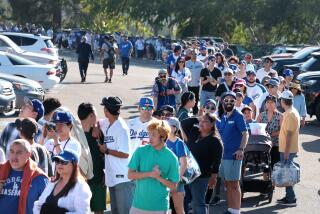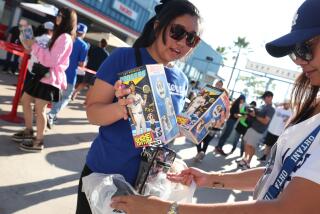Sports Novelty Firms Hatching New Lineup
- Share via
Move over bobble-heads, the matryoshkas are coming!
In the U.S. sports memorabilia market, bobble-heads are starting to lose their bounce. Some in the business are betting that the next promotional hit in stadiums around the country will be Russian nesting dolls, more formally called matryoshkas.
A number of novelty companies are jockeying for licenses and production deals to make a series of hollow, bowling-pin-shaped figures that fit inside each other and bear the likenesses of today’s sports stars.
“To compare it to the bobble-head may be a little premature, but having said that ... this absolutely could be the next wave,” said Brian Jennings, the National Hockey League’s group vice president of consumer products marketing.
At the very least, the timing couldn’t be better, according to those in the industry.
The wildly popular bobble-heads, which have ruled the sports trinket landscape for the last four years, are starting to lose their appeal with fickle sports fans. Professional sports franchises are easing back on their orders of the boingy items as game giveaways. Fourteen teams in the National Basketball Assn. will have in-arena bobble-head promotions this season, down from 20 last year, a league spokesman said.
At Alexander Global, the Bellevue, Wash., company credited with reviving bobble-heads in 1999, U.S. production and retail sales of the dolls are down 50% since 2001, even as demand grows overseas, President Malcolm Alexander said.
“I’d clearly say the bobble-head doll is on the later stages of the product life cycle,” he said. “It has established a solid collectible audience but is not as popular a fad.”
Companies like start-up Newcrafters in Encino believe the next big thing for sports nuts will be a twist on the century-old Russian art form of hand-painted dolls that are stacked, or nested, within bigger dolls.
The plan: Replace the visages and dress of peasant women and storybook characters with the mugs and uniforms of multimillionaire players.
Former Ukrainian basketball player Alexander Krilov and his wife, Julia Butler, said they got the idea for their Nester dolls in the summer of 2000, when fellow countryman and Los Angeles Laker Stanislas “Slava” Medvedenko came to their home.
Medvedenko was on a swing through California to meet his new teammates. As it happened, he packed a matryoshka in his luggage, thinking he might need it for a goodwill gift.
“Slava was so impressed after meeting Shaquille [O’Neal] for the first time, he pulls out the biggest doll and says ‘This is what I’m going to give to Shaquille,’ ” said Butler, a Moscow native. “And one of us came out, ‘Don’t you wish it would be Shaquille’s face on it, instead of this Russian traditional doll?’ ”
Eventually, the couple formed Newcrafters and began the hunt for professional sports league licenses, which would allow it to use team logos and players’ likenesses for retail products.
Krilov said he arranged a meeting with National Basketball Assn. officials through family friend and former Atlanta Hawk player Alexander Volkov, also a Newcrafters investor. The league said nyet at first but changed its mind and granted the new firm a license in September 2001.
That, it turned out, was the easy part. After sinking $250,000 in a new technology to mass produce wooden dolls with the quality demanded by the NBA, Newcrafters took six months to make the first batch of 500 wooden sets featuring members of the Los Angeles Lakers 2002 championship team.
Each set could fetch only $100 retail -- half the amount it cost to produce, ship and promote them.
“We basically lost money but we got experience,” Krilov said. The company moved production from Ukraine to China, then substituted cheaper plastic for wood. It was poised to make some of its money back in the 2002-03 season with a line of $30 dolls featuring Lakers, Dallas Mavericks and Sacramento Kings.
“We decided to take the three best teams of the league and hope that one of them would be champions so we could sell one of them really good,” Krilov said. All three teams lost. The company still has half of that 10,000-piece inventory.
Bolstered with other licenses from the NHL, Major League Baseball and some entertainment properties, Krilov said his company would wade deeper into the untested market.
It has switched back to wood and will be offering even more early this year: 26 collections for the NBA, 13 for professional hockey and 21 featuring major league baseball teams. Then there are the Elvis and “I Love Lucy” dolls. Forty more collections are planned for Christmas.
Krilov projects his annual sales will jump from $150,000 to $1 million, which would allow his company to begin showing a profit.
More established novelty companies are moving on the matryoshka front as well.
One of the biggest, Bensussen Deutsch & Associates Inc. of Woodinville, Wash., came out with its first set of Babooshkah dolls for a Memphis Grizzlies basketball promotion in April. It has since produced nesting doll figures as giveaways for 11 other pro sports teams, including the Texas Rangers baseball club.
Although the firm has obtained a license from Major League Baseball to sell the dolls at retail, it will continue concentrating on supplying the items directly to the teams for promotions, a company official said.
Family-owned Coopersburg Sports Inc., the Pennsylvania firm that boasts being the biggest souvenir bat manufacturer in the world, was inspired to get into the nesting doll business after company president Scott Pino spied the Russian toys in a shopping mall three years ago.
The company raced out to get patents for its line of Stackable Stars, which features raised noses on its doll faces, and has since obtained a license from Major League Baseball and NASCAR.
“We want the nesting dolls to be the next collectible for the next three to five years,” Pino said.
League types are rooting for nesting dolls for others reasons.
The nesting dolls, which typically have three to five dolls in a set, not only offer something new to juice attendance, but they also provide a solution to a sticky problem for a team’s front office, said Bernard Mullin, the NBA’s senior vice president of marketing and team business operations.
By including an entire starting lineup, team executives do not have to decide which player is popular enough to be a bobble-head, he said. It also gives ample room for the possibility that a lesser player may suddenly catch fire and become the big star.
“For political correctness, it makes life a little easier for the marketer and general manager,” Mullin said.
Not everyone’s so sure that offering the full lineup is a good business move.
Malcolm Alexander of Alexander Global sees the series of dolls within a doll as a limitation for manufacturers who need to keep innovating to capture fan attention. In the case of bobble-heads, figures were reborn with big heads, small heads, old uniforms and new uniforms.
“If you have a Russian stacking doll with four or five dolls, it’s half the team,” he said. “How do you perpetuate that piece?”
Then there’s the near certainty that one of the players in the set will be traded, sign with another team or, as is the case with Kobe Bryant of the Lakers, face arrest and possible jail time. That could render a complete set obsolete.
“I don’t think it [nesting dolls] is going to have the durability of a baseball cap or a T-shirt. Or a bobble-head doll,” Alexander said.
A final hurdle is sheer promotional clutter. In the NBA alone this year, teams plan on wooing fans with snow globes, piggy banks, basketballs, action figures, trading cards, T-shirts, wristbands, headbands, lunch boxes and hats.
So far, nesting dolls haven’t broken through. Despite signs of interest among fans and sports executives, the throwbacks to czarist Russia have yet to set a fire in the collectible world, the secondary market that acts as a gauge for a novelty’s ultimate value.
Wayne Grove, price guide editor for Beckett Sports Collectibles, a monthly magazine for hard-core sports memorabilia buffs, says he thinks nesting dolls at this point are more curiosity than keepsake.
“For something to be ... the next bobble-head, it’s got to be something pretty special,” he said. “It’s going to be a long time until we see anything like that again.”


